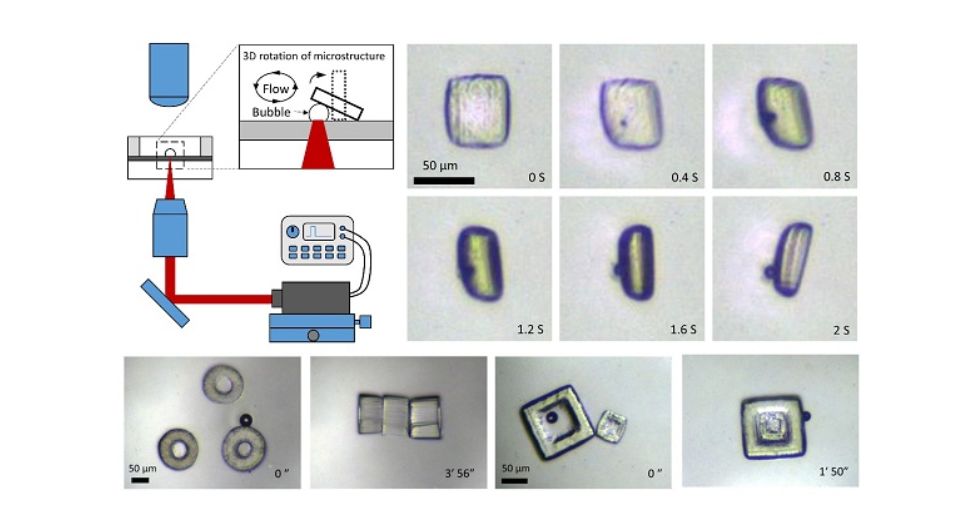Introduction
The potential benefits that micro robots can bring us may exceed our imagination.
Micro robots are typical micro-electromechanical systems. Many countries around the world have made significant achievements in the research of micro robots. Micro robots are very small, comparable in size to dragonflies or flies, and some are even smaller, to the point where we cannot see them. Recently, a research team from the Shenyang Institute of Automation, Chinese Academy of Sciences, has made new progress in the field of micro robots and micro manipulation, with related results published in the international academic journal Small under the title “2D to 3D Manipulation and Assembly of Microstructures Using Optothermally Generated Surface Bubble Microrobots.” Currently developed micro robots can be classified into three main categories:(1) Stationary micro robots. They resemble stones, trees, or flowers and are equipped with various micro sensors that can detect human infrared radiation, ground vibrations during walking, and magnetic field changes caused by the movement of metal objects, transmitting signals to a central command center, which can control weapons in the defense zone to launch attacks automatically.(2) Mobile micro robots. They are equipped with solar panels and computers, capable of maneuvering according to a predetermined program to enter enemy positions and self-destruct.(3) Biological micro robots. Research involves installing micro sensors on animals or insects to create biological micro robots that can enter areas inaccessible to humans to perform combat or reconnaissance missions.The combination of engineering technology and life sciences has become one of the forefront directions of technological innovation. Arranging and assembling microgel structures containing cells into specific configurations and cultivating them into tissue structures with specific biological functions is significant for drug development, biosensing, and research on life-like robots.However, the manipulation and assembly of microstructures, especially the control of three-dimensional poses and the assembly of complex configurations, still face many challenges.The micro-nano research group at the Shenyang Institute of Automation has utilized bubbles in a liquid environment as micro robots to perform three-dimensional manipulation and assembly of microstructures.Researchers have studied methods for generating and controlling bubbles through photothermal effects, using bubble micro robots to perform various operations on hydrogel microstructures, including two-dimensional movement, rotation, and three-dimensional flipping, achieving three-dimensional pose control of microstructures.By integrating these operational methods, bubble micro robots can assemble multiple micro modules into complex three-dimensional structures, providing new solutions for the manipulation and assembly of microstructures and the in vitro construction of biological tissue structures.Application Areas:1. Working at the atomic level. For example, surgeons can remotely control micro robots to perform millimeter-level retinal surgeries, removing elastic retinas or individual pathological cells while the eyeball is in motion, reconnecting severed nerves; they can navigate within patients or blood vessels, immediately killing cancer cells upon detection and scraping off fat accumulated on the aorta; micro robots can also be used for comprehensive examinations of the stomach by inserting an endoscope.2. Precision manufacturing processes, using them to produce computer storage chips with larger capacities and to process ultra-precision “super flat grinding machines,” etc. The operational capabilities of micro robots have reached molecular and atomic levels, far exceeding the level of artists painting on a strand of hair.3. Making various aerospace measurements lighter, household appliances like tape recorders will become smaller and multifunctional, and television screens can be made large and thin, with brightness at each point directly controlled by micro robots. Micro robots will also revolutionize mechanics.4. Carrying cameras and micro fibers, they can enter areas inaccessible to humans to observe the environment, storing or transmitting images. After an underground cable breaks, thousands of micro robots can crawl along the cable, and when they reach the break, they can connect the ends, effectively becoming a permanent link on the cable.5. Cleaning and repairing space telescopes, inspecting spacecraft thermal shields, and de-icing aircraft covers. If a large number of flying micro robots are deployed on other planets, they can send back various required information.
Currently developed micro robots can be classified into three main categories:(1) Stationary micro robots. They resemble stones, trees, or flowers and are equipped with various micro sensors that can detect human infrared radiation, ground vibrations during walking, and magnetic field changes caused by the movement of metal objects, transmitting signals to a central command center, which can control weapons in the defense zone to launch attacks automatically.(2) Mobile micro robots. They are equipped with solar panels and computers, capable of maneuvering according to a predetermined program to enter enemy positions and self-destruct.(3) Biological micro robots. Research involves installing micro sensors on animals or insects to create biological micro robots that can enter areas inaccessible to humans to perform combat or reconnaissance missions.The combination of engineering technology and life sciences has become one of the forefront directions of technological innovation. Arranging and assembling microgel structures containing cells into specific configurations and cultivating them into tissue structures with specific biological functions is significant for drug development, biosensing, and research on life-like robots.However, the manipulation and assembly of microstructures, especially the control of three-dimensional poses and the assembly of complex configurations, still face many challenges.The micro-nano research group at the Shenyang Institute of Automation has utilized bubbles in a liquid environment as micro robots to perform three-dimensional manipulation and assembly of microstructures.Researchers have studied methods for generating and controlling bubbles through photothermal effects, using bubble micro robots to perform various operations on hydrogel microstructures, including two-dimensional movement, rotation, and three-dimensional flipping, achieving three-dimensional pose control of microstructures.By integrating these operational methods, bubble micro robots can assemble multiple micro modules into complex three-dimensional structures, providing new solutions for the manipulation and assembly of microstructures and the in vitro construction of biological tissue structures.Application Areas:1. Working at the atomic level. For example, surgeons can remotely control micro robots to perform millimeter-level retinal surgeries, removing elastic retinas or individual pathological cells while the eyeball is in motion, reconnecting severed nerves; they can navigate within patients or blood vessels, immediately killing cancer cells upon detection and scraping off fat accumulated on the aorta; micro robots can also be used for comprehensive examinations of the stomach by inserting an endoscope.2. Precision manufacturing processes, using them to produce computer storage chips with larger capacities and to process ultra-precision “super flat grinding machines,” etc. The operational capabilities of micro robots have reached molecular and atomic levels, far exceeding the level of artists painting on a strand of hair.3. Making various aerospace measurements lighter, household appliances like tape recorders will become smaller and multifunctional, and television screens can be made large and thin, with brightness at each point directly controlled by micro robots. Micro robots will also revolutionize mechanics.4. Carrying cameras and micro fibers, they can enter areas inaccessible to humans to observe the environment, storing or transmitting images. After an underground cable breaks, thousands of micro robots can crawl along the cable, and when they reach the break, they can connect the ends, effectively becoming a permanent link on the cable.5. Cleaning and repairing space telescopes, inspecting spacecraft thermal shields, and de-icing aircraft covers. If a large number of flying micro robots are deployed on other planets, they can send back various required information.
Highlights
[Capital] Analysis of the correlation between the robot industry value and returns from three dimensions[Industry] Application case of RFID technology in automotive production lines[Frontier] New tactile arms help robots achieve touch more easily[Analysis] What are the main technical issues currently facing industrial robots?[International] Google drone delivery has arrived!
Disclaimer
Source: Shenyang Institute of Automation
Any information sourced from other media is reprinted from other media and does not represent our platform’s endorsement of its views, nor does it represent our platform’s responsibility for its authenticity. If you have any questions or doubts about the content of this article, please contact the editor immediately, and the platform will respond and handle it promptly. For original content from our company, please contact us for reprints!
